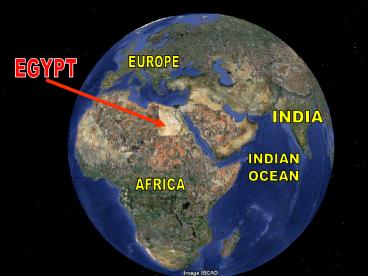EGYPT - PowerPoint PPT Presentation
1 / 14
Title:
EGYPT
Description:
The Egyptian Empire About 1450 B.C. Geography of the Ancient Nile Valley Egypt is wholly the gift of the Nile. Herodotus People settled and established ... – PowerPoint PPT presentation
Number of Views:245
Avg rating:3.0/5.0
Title: EGYPT
1
EUROPE
EGYPT
INDIA
INDIAN OCEAN
AFRICA
2
NILE RIVER
RED SEA
EGYPT
3
DESERT
NILE RIVER
FERTILE GROUND
DESERT
4
(No Transcript)
5
PYRAMIDS
6
The Egyptian Empire About 1450 B.C.
1
7
Geography of the Ancient Nile Valley
1
- Egypt is wholly the gift of the Nile.
Herodotus - People settled and established farming villages
along the Nile. - Egyptians depended on annual floods to soak the
land and deposit a layer of silt, or rich soil. - Egyptians had to cooperate to control the Nile,
building dikes, reservoirs, and irrigation
ditches. - Rulers used the Nile to link and unite Upper and
Lower Egypt. - The Nile served as a trade route connecting Egypt
to Africa, the Middle East, and the Mediterranean
world.
8
Three Kingdoms of Ancient Egypt
1
NEW KINGDOM
MIDDLE KINGDOM
OLD KINGDOM
Powerful pharaohs created a large empire that
reached the Euphrates River. Hatshepsut
encouraged trade. Ramses II expanded Egyptian
rule to Syria. Egyptian power declined.
Pharaohs organized a strong central state, were
absolute rulers, and were considered
gods. Egyptians built pyramids at Giza. Power
struggles, crop failures, and cost of pyramids
contributed to the collapse of the Old Kingdom.
Large drainage project created arable
farmland. Traders had contacts with Middle East
and Crete. Corruption and rebellions were
common. Hyksos invaded and occupied the delta
region.
9
Egypt and Nubia
1
- For centuries, Egypt traded or fought with Nubia.
- During the New Kingdom, Egypt conquered Nubia.
- Nubians served in Egyptian armies and influenced
Egyptian culture. - Egyptian art from this period shows Nubian
soldiers, musicians, or prisoners. - When Egypt declined, Nubia conquered Egypt.
- Nubians did not see themselves as conquerors.
They respected Egyptian traditions.
10
2/1 VOCABULARY
- Menes 7. silt
- Ptah-hotep 8. cataract
- Giza 9. delta
- Hatshepsut 10. dynasty
- Ramses II 11. pharaoh
- Hyksos 12. vizier
11
2/1 MAIN IDEAS
- Why did Egyptians look forward to the annual
- flooding of the Nile River?
- Why did the Egyptians of the Old Kingdom design
and build the pyramids? - How would you summarize the Middle Kingdom?
- List 2 results of the New Kingdoms expansion
- Summarize the relationship between Egypt Nubia
12
Egyptian Religious Beliefs
2
- Belief that many gods and goddesses ruled the
world and the afterlife.
Amon-Re
was the sun god.
Osiris was the god of
the underworld and of the Nile.
The pharaoh was believed to be a god as well as
a monarch. - Belief in eternal life after death.
Relied on the Book of the Dead to help them
through the afterworld.
Practiced mummification, the
preservation of the body for use in the next
life.
13
Ancient Egypt A Center of Learning Culture
2
Advances in Learning
Advances in the Arts
Statues, paintings, and writings tell us about
ancient Egyptian values and attitudes. Developed
painting style that remained unchanged for
thousands of years. Wrote hymns and prayers to
the gods, proverbs, love poems, stories of
victory in battle, and folk tales. Built
pyramids and other great buildings, such as
temple of Ramses II.
Developed a form of picture writing called
hieroglyphics. Doctors diagnosed and cured
illnesses, performed surgery, and developed
medicines still used today. Developed 12-month
calendar on which modern calendar is
based. Astronomers mapped constellations and
charted movement of the planets. Developed
practical geometry. Skilled in design and
engineering.
14
Class System in Ancient Egypt
2
PHARAOH Earthly leader considered a god
HIGH PRIESTS AND PRIESTESSES Served gods and
goddesses
NOBLES Fought pharaohs wars
MERCHANTS, SCRIBES, AND ARTISANS Made furniture,
jewelry, and fabrics for pharaohs and nobles, and
provided for other needs
PEASANT FARMERS AND SLAVES Worked in the fields
and served the pharaoh































